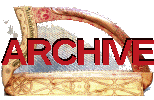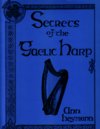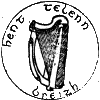
|

Let Erin
Remember,
1979
The current revival dates from the early 1970s. At that time, American Jay Witcher started making accurate replicas of the early Gaelic harps preserved in museums in Ireland. From the beginning he used historical and scientific principles to make replica instruments, rather than starting from contemporary classical or folk harp practice. By something of a coincidence, American Ann Heymann read Edward Bunting's 1840 book1 in which he not only printed many tunes from the old Gaelic harp repertory, but also included details on fingerings, tunings and other technical details on the playing of the instrument. In 1974 she bought one of Jay's harps - a copy of the 16th/17th century Castle Otway harp - and started applying Bunting's instructions2. In 1979 she released a LP "Let Erin Remember" with her husband Charlie; this is almost certainly the first commercial recording of the early Gaelic harp played with the fingernails using the old left hand treble/right hand bass playing orientation of the old harpers.

The first
tutor book,
1988
Ann has written an number of key tutor and repertory books3, and she is still teaching, performing and perhaps most importantly researching all aspects of the Gaelic harp tradition. Over the last 30 years many other people have followed her lead and started playing good replica instruments using historical techniques and repertories, not least established professionals in the contemporary lever harp tradition. Gráinne Yeats acquired harps by Jay Witcher, and used them on her double LP "Féile na gChruitirí Bhéal Feirste 1792" in 1980, and Scottish harper Alison Kinnaird acquired a replica of the Lamont harp by Bob Evans, which features on her new CD "The Silver String". A number of other harp makers have started offering accurate replicas of the old instruments, including David Kortier in America, Tim Hobrough in Scotland, and George Stevens in England.

There are now teachers and students in a number of countries, notably the USA and France. The Breton organisation Hent Telenn Breizh, headed by harpmaker Joël Herrou and harper Violaine Mayor, has run a successful annual summer school, Telenn ar Gelted, since 1998. Violaine is one of the few people to follow Ann Heymann in adhering to the traditional left shoulder playing orientation, most players of the early Gaelic harp today compromising by adopting the modern right shoulder convention.
In the 1990s Bill Taylor, a harpist and apprentice of Tim Hobrough, set up Ardival Harps in Scotland to make and sell a standard line of harps. These are of a modern design, suitable for easy use by people used to medieval instruments of the "early music" revival; they combine elements of the old Gaelic harp tradition with modern aesthetic and design features. In 2000 Bill started the Wire Branch of the Clarsach Society, a new section of the Clarsach Society which had promoted the playing of the lever harp in Scotland since 1931. This helped ensure that the annual Edinburgh Harp Festival was guaranteed to contain lessons for students of the modern 'wire-strung harp'. The Branch's newsletter and website, clarsach.net, publish listings and directories of events and resources.
In Ireland Siobhán Armstrong, a harpist who specialises in historical harps for baroque music and opera, started applying her historical training to the early Irish harp, and in 2002 she founded the Historical Harp Society of Ireland to promote the instrument and run the annual summer school Scoil na gCláirseach in Kilkenny. The HHSI is working with the harpmaker David Kortier to produce accurate measured replicas of the surviving historic instruments, in an affordable form for sale and rent to students; the first Student Trinity harps were delivered in June 2005.
And late in 2004 Simon Chadwick, a self-taught harper, (from Ann Heymann's books), set up earlygaelicharp.info as an independent website to assist the revival by compiling and presenting all manner of information on the instrument, its music and traditions.
Whatever next?